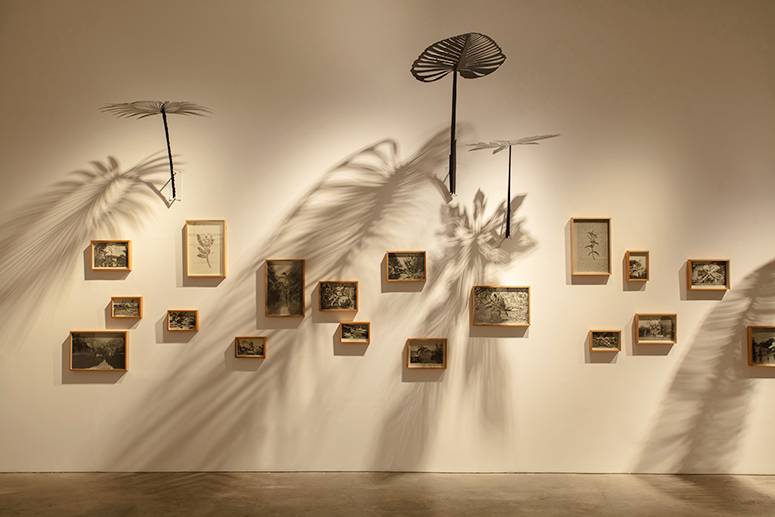Paper’s elusive histories
Ryan Villamael is no stranger to the sprawl of things. In his work “Locus Amoneus,” which was first exhibited in 2016 for the Singapore Biennale, paper foliage creeps through the space, resembling an overgrowth of vines. Meanwhile, in the 2017 Silverlens show “Epilogue,” Villamael took sheets of paper from old books culled from antique shops and garage sales over the years and painstakingly structured them— cut, layered, and superimposed them—into careful shapes that practically spilled open.
His works usually draw upon the expansive qualities of paper while also fruitfully interrogating the medium’s history of containment. The latticework of “Locus Amoneus” derives from 16th-century Philippine maps set back-to-back against facsimiles of contemporary maps, fabricating a sort of cartographic foliage in the process. “I deal with history a lot in my practice, narratives patched together from disparate accounts and experiences,” he said in a 2021 interview. Within that recounting lies a visceral tension, in the attempt to forge narrative out of the clutter of history, which Villamael applies to his papercuts: the disarray often emerges from the artist’s controlled and refined sense of craft.
A product of a household torn by distance (his father emigrated to the Middle East as an Overseas Filipino Worker and eventually disappeared from the artist’s life altogether), Villamael seems most interested in depicting personal and national history as conditioned by the uneven terrain of geopolitics. How a history of colonization creates demarcations both mental and geographic.
Paper, acting as the artist’s sculptural medium, carries with it a wide-ranging potency—despite, or perhaps because of, its delicate intricacy. Capable of unveiling power relations that often go unnoticed, paper discloses the records of history, from its tactile surface to printed matter. “Return, My Gracious Hour” is Villamael’s latest solo show and carries with it an insularity unique to his body of work.

The exhibition features most prominently a series of 30 framed paper cutouts extracted from History and Description of the Picturesque Philippines by Ebenezer B. Hannaford. Defacing the texts and illustrations of Hannaford’s document, Villamael juxtaposes its pages with elaborately crafted, miniature floral papercuts. Here, as in his prior works, Villamael channels history as a vehicle for cleaving its racialized hold on the present. “Suffice it that the Filipino is as yet a child, sometimes naughty, sometimes petulant and rebellious,” reads one patronizing passage from the series, “but still a child.”
In these enclosed frames, Villamael searches for a form of rupture: between the past and present, the colonial gaze and its contemporary manifestations, the imagined world of the West and the lived experience of the Filipino. Encountering these works, I feel most inclined to describe Villamael’s artistic interventions as a kind of indirect translation, shuttling precariously between the language of Hannaford’s text and the visual, tactile language of paper. “An arresting translation,” Edgar Calabia Samar wrote of Ben Aguilar’s robust translation of Forth by poet Rosmon Tuazon, “is like being always on the verge of drowning in the time and form of the source—and then recognizing that words can actually consume the current and break forth into its own mangled molds of survival.”

Villamael engages in a similar dynamic in “Return, My Gracious Hour” as these works absorb the currents of history while cracking open its manifold possibilities. The installation works “Insulae Philippinae” and “14.1699° N, 121.2441° E,” which bookend the exhibition, introduce wood and charcoal as the artist sculpts figures of fruits on a platter, laying them out sensually. In both pieces, paper accompanies the carvings, materializing as jigsaw cutouts and watercolor smears.

Continuing Villamael’s interest in cartography, “Insulae Philippinae” draws its title from one of the first maps solely depicting the Philippines. Deconstructing the map and then blowing it up into jigsaw pieces, the work acts as a critique of the arbitrary nature of map-making. Elsewhere, the reflective metal sculpture “Fables” stages a labyrinthine mesh, incorporating tropical imagery such as crab and palm fronds into its fold. Villamael brings a level of detailed craftsmanship to most of his works but “Fables,” brimming with a tantalizing showiness, is the clearest showcase of that talent. These works mark an aptitude for precision, a generosity of specifics that collapses visual sensuousness with intellectual curiosity.

The porous borders of personal and national history have been fertile ground for artists as of late. Visual artist Costantino Zicarelli, whose 2023 show investigated archival materials of Philippine colonial history and interposed them with autofictional details, is one such example of this tendency. Like Zicarelli, Villamael represents and repurposes colonial narratives as a way of undercutting them, but his method has a far more tender tinge. There’s an emotionalism to his papercuts, a waft of wistfulness peaking through the edges, that resists a straightforward critique of the past.
Delving into the archives, or any history for that matter, brings us face-to-face with all its ambivalences. It is almost always difficult work. “Tender childhood, beautiful town,” wrote Jose Rizal in his poem “Memories of My Town,” recalling his earliest memories of happiness living in Calamba, Laguna. “[R]eturn to this heart of mine, return my gracious hours.” Villamael shows us that the path to understanding the past is full of crags and troughs, that to return to the past is to allow oneself to be transformed within the present.
* * *
“Return, My Gracious Hour” was shown at Silverlens Gallery until Feb. 3.


